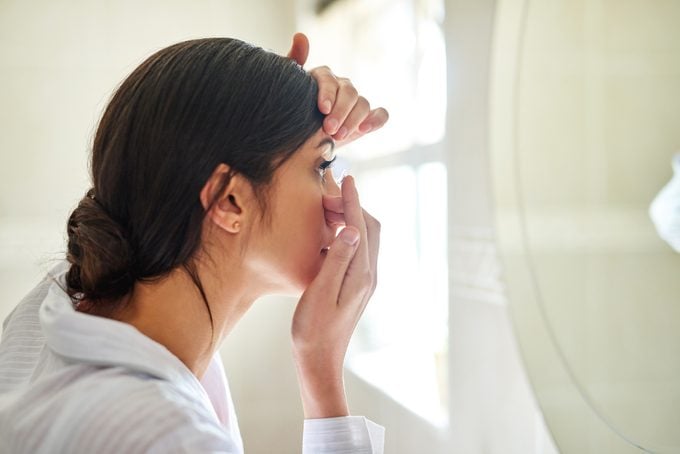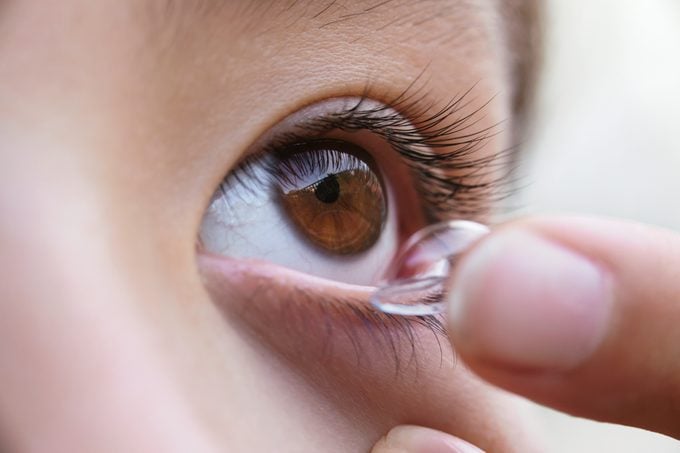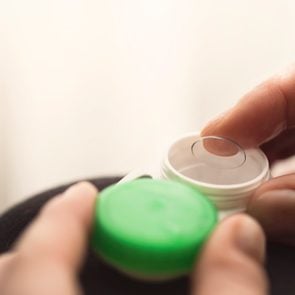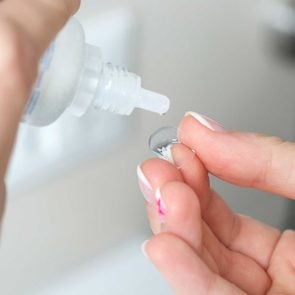Here’s How to Put in Your Contacts if You’re a Beginner
Updated: Oct. 25, 2021
Learning how to put in your contact lenses takes practice. Eye doctors walk through the steps and review how to care for your lenses.
How to put in contacts
The first step to putting in contact lenses is one that should require no practice: Wash your hands. You don’t want to touch your contact lenses with grimy fingers. Make sure you do it correctly.
“Cleaning your hands is very important,” says ophthalmologist Mark Fromer, MD, of Lenox Hill Hospital in New York City. “The greatest risk is the formation of an ulcer on your cornea as the result of bacteria.”
Use soap and warm water to get your hands clean. Do not use hand sanitizer. That doesn’t play well with contacts, says Michelle Battaglia-Capogna, OD, an optometrist at Northwell Health Ophthalmology in Great Neck, New York.
“Wash your hands, then make sure you don’t do anything else before you put in your contacts,” says Dr. Battaglia-Capogna. That means don’t use any hand lotions, perfumes, or creams.
“Also, when drying your hands, avoid towels that have lint, because you don’t want anything on your hands that you can pass to your contact lenses,” Dr. Battaglia-Capogna adds.
Here’s everything else you need to know about how to put in contacts, including how to take out contacts and more.
Examine your contacts
Now, get in front of a mirror and remove the contact lens by letting it slide out of its case and into your palm, then place it on the tip of your finger, according to the American Academy of Ophthalmology. Do not touch it with your fingernails, which can scratch or tear it.
Before you put it in, give the lens a once-over. You want to make sure there are no tears in the lens or anything stuck to the surface. If it is torn, discard it. If there’s anything on it, give it a rinse with your contact lens solution.
Next, don’t assume your contact lens is oriented properly. It may be inside-out. Here’s a quick test you can do: Fold it like a taco. If you can do that easily, so the edges come together, you’re ready to go. If you get resistance, it’s likely inside-out. You can easily reverse it.
Still not sure? No problem, Dr. Battaglia-Capogna says: “If you simply can’t tell, go ahead and put it in to see if it feels comfortable. Most people can tell right away if it’s in wrong. It won’t be comfortable because the fit’s not correct.”
Use your dominant hand

OK, you’re ready to put it in. Try to relax. Dr. Battaglia-Capogna says many people have an ingrained aversion to putting things in their eyes (in general, that’s a good thing!), so you may have to take a deep breath to calm yourself. It may help, she says, to watch a few YouTube videos to see other people do it.
Hold your eyelids open wide so your eyelashes don’t touch your contact, then place the lens onto your eye.
“You have to be comfortable with touching your eyes and eyelids, because you have to make sure that not one eyelash is touching the contact lens,” Dr. Battaglia-Capogna says. “If it is, you won’t get the contact lens in.”
Keep in mind that once the contact is in properly, you should not feel it.
“If you feel anything, take it out and check it again, then rinse it,” Dr. Battaglia-Capogna says.
Once it’s on your eye, close your eye and move it around a bit so the lens seats properly and comfortably. You’re done!
How to take out contacts

When you’re ready to remove your contact lenses, wash your hands thoroughly, then dry them with a lint-free towel. Pull your lower eyelid down and hold your upper eyelid open.
Use the tip of an index finger to gently move the lens to the outer white part of your eye, then bring your thumb in and use it to carefully squeeze—don’t pinch—the lens and pull it out. Make sure your nails don’t touch your eyes.
Practice makes perfect
But wait, the lesson’s not quite over.
First, rest assured that the more you do it, the easier and faster putting in your contacts will become. Eventually, you will be able to do it without the help of a mirror.
Also, your doctor should give a thorough tutorial when you pick up your first batch of lenses. Once you’ve practiced for a bit, you’ll likely find a way that’s comfortable for you. Don’t worry if it’s different from what you know. The goal is to get the contact in safely and comfortably. How you do that is up to you.
“Don’t pay attention to how other people put theirs in,” Dr. Battaglia-Capogna says. “It will be different from how it’s comfortable for you, and you will get used to it.”
Follow directions
Wearing contacts requires developing more than the dexterity it takes to get them in your eyes. You also need to cultivate some good hygiene habits that will help keep your eyes safe.
Making mistakes or getting lazy, Dr. Fromer says, can lead to pain, discomfort, red eye, and even vision loss.
It’s crucial to follow your doctor’s and your contact lens manufacturer’s instructions about cleaning your lenses. Additionally, wear them only as long as directed. Daily lenses, for example, should be discarded at the end of the day. It may be tempting to hold onto them if they still feel comfortable, but you are asking for trouble.
“You can get eye infections with contact lenses,” Dr. Battaglia-Capogna says. “Serious, vision-threatening infections.”
Limit how long you keep them in
You also want to avoid wearing contact lenses for too many hours. Why? Though they let oxygen through to your cornea, you won’t get as much oxygen as your eyes need if you leave them in too long.
“The cornea can become ischemic,” Dr. Fromer says. “That means a lack of oxygen, which can lead to a breakdown of the corneal surface. Corneal abrasions also can occur.”
Both threaten your vision.
Dr. Battaglia-Capogna recommends putting your contacts in before heading to work, then taking them out and wearing your glasses when you get home.
“Think of it like slipping into sweatpants,” she says.
If you know you’ll be out late on a Friday or Saturday night, wear your glasses until you’re getting ready to party.
Speaking of glasses, Dr. Battaglia-Capogna also advises people to keep an up-to-date pair of glasses, in frames that you like, so you have a ready stand-in for your contacts when it’s time to remove them.
If your glasses have an old prescription or are in frames you’d be embarrassed to be seen in, you’ll be tempted to leave your contacts in longer than you should.
Next, check out the worst contact lens mistakes.

![This-Is-What-Would-Happen-If-You-Never-Took-Out-Your-Contacts-[AP]-626461688-life-literacy-ft](https://www.thehealthy.com/wp-content/uploads/2017/07/This-Is-What-Would-Happen-If-You-Never-Took-Out-Your-Contacts-AP-626461688-life-literacy-ft.jpg?resize=295%2C295)

